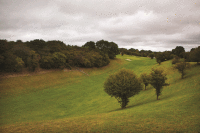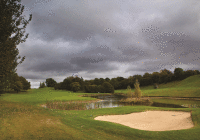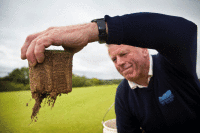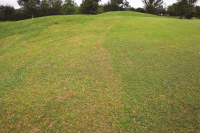The Greens Revolution

Designed by Christy O'Connor Junior, construction of Esker Hills 18 hole golf course, with USGA specification greens, began in 1994. With minimum soil disturbance, a wonderful course through Mother Nature's own sand hills and sweeping valleys was created. It opened for play the following year.
One big claim to fame that Esker Hills has is that PGA Tour golfer Shane Lowry started his golf here. His father Brendan organises junior golf at the club and what a proud father he must have been when Shane won the 2009 Irish Open at Co. Louth as an amateur. Shane never forgot his roots and is a regular visitor to the club, in between his busy tour schedule, and is a great supporter of junior golf.

The Course Superintendent at Esker Hills is Willie Allen. He came to the club in 2000, having previously spent fifteen years maintaining the course at nearby Moate Golf Club. Back then, the greens at Esker Hills were bent/fescue, with some poa annua thrown in for good measure.
With every successful course comes a successful team. Tom Naughton, Valdis Grikovs and Valdis Parfjonov work with Willie as part of the greenkeeping staff and have many years of experience between them.
One thing that favours Esker Hills is the free draining soil lying underneath the entire course. In fact, it is more sand and gravel than soil and, because of this, members from clubs, both far and near, head for the course during wet weather, particularly in winter. Ground conditions are so favourable that even golf buggies are allowed on the course throughout the entire year.
But the real jewel in the crown is not the free drainage of the course, but the revolution that has taken place on the greens. From poa sward, Willie has turned the greens into an almost 100% fescue surface with only a tiny amount of bent and poa left after four years. He is very proud of the feedback and, as word spreads, many greenkeepers are coming to see for themselves what he has done. So, how did he manage it? Willie holds back no secrets on his success.

"I explained the key advantages and what discomfort there might be, but the wish to have consistent, true and smooth greens was a prize the members and management jumped at and gave their full support.
"I invested heavily in seed and started overseeding the greens with fescue in April of that year, using a dimple seeder. I managed my fertiliser programme carefully and concentrated on overseeding and more overseeding.'"

The grass gets hardly any disease now. In fact, Willie has not sprayed fungicide since December 2012. His nitrogen inputs are now reduced to between 32-36 units/hectare (from a high of 150 units in 2007). His annual phosphorous and potassium applications have also been reduced. They are now down to 11 units and 48 units respectively, from a high of 50 units and 240 units. Willie often seeks the advice of his colleague, Fintan Brennan of Portmarnock Golf Links, a man who knows all about fescue.

It has been three years since he last hollow cored the greens. Instead, he solid tines with 5mm pencil tines each spring and autumn, along with an application of around 27 tonnes of sand over the eighteen greens. He only scarifies the greens once each year. Greens slitting is carried out three or four times during the winter.
Willie has seen huge benefits with the changeover. Because fescue is a fine leaf grass, it is possible to mow at higher heights without losing green speed. Willie mows as high as 5mm in summer and has invested in a TruTurf greens iron, which also helps in keeping the green speed up. With such a high height of cut, he can still manage to get a reading of 11 on the stimpmeter.

He has not sprayed wetting agent on the greens for two years. The result of using no fungicides and wetting agents, with better fertiliser regimes, can be seen on the greens, and it has made a big saving on the annual course maintenance budget, a saving of €7,500 (£6,000) every year.
Not happy with his lot, Willie also wanted to enlarge the greens. He mowed out into the aprons, at greens mowing height, where a lot of perennial ryegrass was growing, and managed to rid the collars of a lot of the rye with the help of the overseeding. Spraying with Rescue last autumn helped to eliminate the remaining ryegrass and he is continually mowing out further into the surrounds to kill off the ryegrass and weeds as he does so.

"I would like to see a situation where the golfer will be putting many yards away from the green instead of chipping - just like you see on links courses."
In just four years, Willie has transformed the greens at Esker Hills without a sod being turned over. This method of greens transformation has got great support from the members. His boss was so impressed with what Willie and his staff have achieved that he got an article put in the local newspaper. Even Shane Lowry gave him compliments.

The quality of the greens has been instrumental in attracting new members and a surge in visitor numbers.
You will have to visit Esker Hills to see the greens revolution for yourself.
This article first appeared in Greenside, the official publication of the GCSAI
What's in the shed?
John Deere 220B pedestrian mower
John Deere 220A pedestrian mowers x 4
John Deere 2500 triplex
Toro Greenmaster mowers x 3
Jacobsen Greens King IV tees mower
John Deere 1200A bunker rake
Allen National 64 mower
Jacobsen LF3800 fairway mower
Jacobsen 5111 rough mower
Jacobsen TR3 mounds mower
Stihl FS350 strimmers x 2
Ryan sodcutter
Blec Multiseeder
Allen 450 hover mower
Tru-Turf greens iron
Toro Workman
Atom Golf bunker edger
Everris fertiliser spreaders x 2
Ultra spreader
Iseki 530 tractor
Ford 1520 tractor
Massey Ferguson 135 tractor
Stihl HS 81R hedge trimmer
Stihl BR 420 leaf blower
Agrimetal BW 300 leaf blower
Hardi 200lt sprayers x 2
Yes 300lt sprayer
Sisis slitter
Wiedenmann 7416 TerraSpike
Hunter Juno in-situ grinder and hoist
